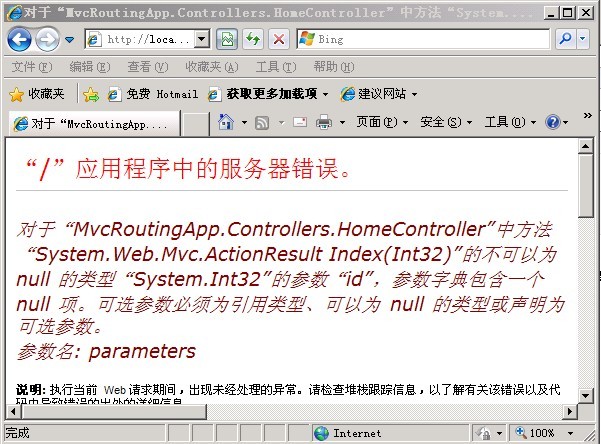[转载]ASP.NET MVC Routing概述 (C#) – JasenKin – 博客园.
ASP.NET MVC Routing概述
ASP.NET Routing模块的责任是将传入的浏览器请求映射为特有的MVC controller actions。
使用默认的Route Table
当你创建一个新的ASP.NET MVC应用程序,这个应用程序已经被配置用来使用ASP.NET Routing。 ASP.NET Routing 在2个地方设置。第一个,ASP.NET Routing 在你的应用程序中的Web配置文件(Web.config文件)是有效的。在配置文件中有4个与routing相关的代码片 段:system.web.httpModules代码段,system.web.httpHandlers 代码段,system.webserver.modules代码段以及 system.webserver.handlers代码段。千万注意不要删除这些代码段,如果没有这些代码段,routing将不再运行。第二个,更重 要的,route table在应用程序的Global.asax文件中创建。这个Global.asax文件是一个特殊的文件,它包含ASP.NET 应用程序生命周期events的event handlers。这个route table在应用程序的起始event中创将。
在Listing 1中包含ASP.NET MVC应用程序的默认Global.asax文件.
Listing 1 – Global.asax.cs
1 public class MvcApplication : System.Web.HttpApplication 2 { 3 public static void RegisterRoutes(RouteCollection routes) 4 { 5 routes.IgnoreRoute("{resource}.axd/{*pathInfo}"); 6 routes.MapRoute( 7 "Default", // 路由名称 8 "{controller}/{action}/{id}", // 带有参数的 URL 9 new { controller = "Home", action = "Index", id = UrlParameter.Optional } // 参数默认值10 );1112 }1314 protected void Application_Start()15 {16 AreaRegistration.RegisterAllAreas();1718 RegisterRoutes(RouteTable.Routes);19 }20 } |
当一个MVC应用程序第一个启动,Application_Start() 方法被调用,这个方法反过来调用RegisterRoutes() 方法。
这个默认的route table包含一个单一的route。这个默认的route将url的第一个段映射为一个controller名称,url的第二个段映射为一个controller action,第三个段映射为命名为id的参数。
假如,你在网页浏览器的地址栏中键入下面的url:/Home/Index/3,这个默认的route将这个url映射为下面的参数:
controller = Home controller名称
action = Index controller action
id = 3 id的参数
当你请求/Home/Index/3这样的url,下面的代码将执行。HomeController.Index(3)
这个默认的route包含3个默认的参数。如果你没有提供一个 controller,那么 controller默认为Home。同样,action默认为Index,id参数默认为空字符串。
让我们来看一些关于默认的route怎么映射urls为controller actions的例子。假如你在你的浏览器地址栏中输入如下的url:/Home, 由于这些默认的route参数有一些相关的默认值,键入这样的URL,将导致HomeController类的Index()方法(如Listing 2)被调用。
1 namespace MvcRoutingApp.Controllers 2 { 3 [HandleError] 4 public class HomeController : Controller 5 { 6 public ActionResult Index(string id) 7 { 8 ViewData["Message"] = "欢迎使用 ASP.NET MVC!"; 910 return View();11 }1213 public ActionResult About()14 {15 return View();16 }17 }18 }19 |
在Listing 2中,这个HomeController 类包含一个名为Index()的方法。这个URL /Home导致Index()方法被调用,一个空的字符串将作为id参数的值。由于mvc框架调用controller actions的这种方式,这个URL /Home同样匹配HomeController类中的Index()方法(如Listing 3)。
Listing 3 – HomeController.cs (Index action with no parameter)
[HandleError]
public class HomeController : Controller
{
public ActionResult Index()
{
return View();
}
}
在Listing 3中,这个Index()方法不接收任何参数。这个URL /Home将导致Index()方法被调用。URL /Home/Index/3同样调用这个方法(ID被忽略)。
Listing 4 – HomeController.cs (Index action with nullable parameter)
[HandleError]
public class HomeController : Controller
{
public ActionResult Index(int? id)
{
return View();
}
}
在Listing 4中, Index() 方法有一个整数参数. 由于这个参数是可空参数 , Index() 将被调用而不引起错误.
最后, 使用 URL /Home 来调用如Listing 5中的Index() 方法 将导致异常,因为这个ID参数不是一个可空的参数。如果你试图去调用这个Index()方法,你将获得如下图所示的错误。

Listing 5 – HomeController.cs (Index action with Id parameter)
[HandleError]
public class HomeController : Controller
{
public ActionResult Index(int id)
{
return View();
}
}
另一方面,使用如Listing 5中的Index controller action,URL /Home/Index/3运行正常。Index controller action in Listing 5. /Home/Index/3请求将导致Index()方法被调用,ID参数拥有一个3的值。
总结
这是一个关于ASP.NET Routing的简要介绍. 应该了解了这个默认的route如何将URLs映射为controller actions。
创建自定义的Routes (C#)
这个教程,你将学会怎样添加一个自定义的route到一个ASP.NET MVC应用程序。你将学会在Global.asax文件中,怎样使用一个自定义的route来修改这个默认的route table。
对于许多简单的ASP.NET MVC 应用程序,这个默认的route table将运行得很好。然而,你可能发现,你可能特定的routing 需求。那样的话,你可能需要创建一个自定义的route。
设想一下,例如,你正在建立一个博客应用程序,你可能想要去处理像/Archive/12-25-2009的输入请求。
当一个用户键入这个请求,你想要返回与日期为12/25/2009相符的博客实体。为了处理这种类型的请求,你需要去创建一个自定义的route。
在 Listing 1中,这个Global.asax文件中包含一个新的名为Blog的自定义route,它处理类似于/Archive/entry date的请求。
Listing 1 – Global.asax (with custom route)
1 using System; 2 using System.Collections.Generic; 3 using System.Linq; 4 using System.Web; 5 using System.Web.Mvc; 6 using System.Web.Routing; 7 8 namespace MvcRoutingApp 9 {10 // 注意: 有关启用 IIS6 或 IIS7 经典模式的说明,11 // 请访问 http://go.microsoft.com/?LinkId=939480112 13 public class MvcApplication : System.Web.HttpApplication14 {15 public static void RegisterRoutes(RouteCollection routes)16 {17 routes.IgnoreRoute("{resource}.axd/{*pathInfo}");18 routes.MapRoute(19 "Blog", // 路由名称20 "Archive/{entryDate}/{id}", // 带有参数的 URL21 new { controller = "Archive", action = "Entry", id = UrlParameter.Optional } // 参数默认值22 );23 routes.MapRoute(24 "Default", // 路由名称25 "{controller}/{action}/{id}", // 带有参数的 URL26 new { controller = "Home", action = "Index", id = UrlParameter.Optional } // 参数默认值27 );28 29 }30 31 protected void Application_Start()32 {33 AreaRegistration.RegisterAllAreas();34 35 RegisterRoutes(RouteTable.Routes);36 }37 }38 } |
你添加到route table的routes的顺序是很重要的。我们新自定义的blog route在现存的默认route之前添加。如果你颠倒了顺序,那么这个默认的route总是先调用而不是这个自定义的route。
这个自定义的blog toute匹配任何以 /Archive/ 开头的请求。所以,它匹配所有下列URLs:
/Archive/12-25-2009
/Archive/10-6-2004
/Archive/apple
这个自定义的route将输入的请求映射至名为Archive的controller,并且调用 Entry() action。当 Entry() action被调用的时候,这个输入的日期被当作名为entryDate的参数。
Listing 2 – ArchiveController.cs
public class ArchiveController : Controller
{
public string Entry(DateTime entryDate)
{
return “You requested the date:” + entryDate.ToString();
}
}
注意,在Listing 2中这个Entry()方法接收一个类型为DateTime的参数。MVC框架是足够智能的,它自动将URL中输入的date转换为一个DateTime值。如果URL中输入的date不能转换为DateTime,错误将被引发。
总结
这个教程演示怎样来创建一个自定义的route。你学会了怎样在Global.asax 文件中添加一个自定义的route到route table。我们讨论了怎样为blog实体将请求映射为名为ArchiveController的controller,名为Entry()的controller action。
 Mikel
Mikel

